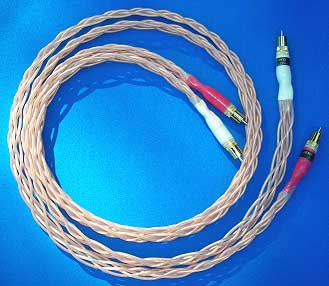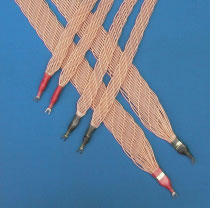
I won’t say that Jena Labs builds multi-stranded audio cables to endure unnatural physical stresses (they just might, however I wasn’t about to test the review set!), but they do believe their woven or “braided” cord technology creates a musical chord that is “not easily broken” – that is, sounds superior to single strand cabling. After hearing the Jena Labs Jazz IC’s, speaker cables and power cords in my system for several weeks I would agree that there are significant qualities of the braided cable technology which are worth exploring.
Jena Jazz
I recall an experiment I conducted when I first entered into the audio hobby. I should have known then that it would foreshadow my entrance into the field of reviewing equipment. I had a system that didn’t even scrape the bottom of the high-end – as a just hatched professional, out of school with prodigious debt, I had a most modest rig. I think I was using 16 ga. wiring, more like lamp cord than speaker cables. I visited a high-end store, saw the impressive cabling, and came away with an idea only a desperate and broke audiophile wannabe could dream up – I would make DIY speaker cables.
I went to the local homebuilding store and purchased the fattest cabling that could be bent with two hands! I remember that the outer jacket was bright yellow – a perfectly ghastly color for any décor. Inside were three rather thick individual wires each with its own sheath arranged in a braided twist. It would be a nightmare for WAF; a very good thing I wasn’t married at the time. However, my future wife was starting to get indications I wasn’t normal. Little did she know…
I was amazed, the cable did make a slight difference! Even with mediocre equipment, I could definitely hear a bit fuller, cleaner sound and a bit more extension in the low end. That one experiment confirmed to me that there can be noticeable differences between cables based on construction. Not long after, I tried a primitive version of what I have before me now as the Jena Labs Jazz, by combining three smaller strands and joining them at the binding posts.
Having conducted my experiment (hey, at least I didn’t try the home cryo treatment by sticking them in the freezer!) I can have an appreciation for the amount of hand work in making braided cables. One time when I was desperate for a run of cable, I obtained some bulk, biwirng Audioquest Crystal II. I stripped the 96 internal wires and terminated them. What a pain! When you pay good money for braided cables, you’re in part paying someone else to take away your pain and replace it with pleasure. The older I get, the more that sounds like a good deal. One glance at the Jena Labs cabling will tell you that someone has endured the issues with multi-stranded cables to bring this woven wonder to you.
One potential problem with such thick runs of cabling coming to convergence in a connector is the multiplicity of wires terminating underneath the shrink wrap becoming bulkier than the connector. The end result is a bulge in the cable just beyond the connector. On certain components, such as the Rega Saturn, the jacks are spaced rather closely together, since the factory never anticipated the use of bulbous IC’s.
Jena Java
The shrink wrap covered terminations of the Java IC’s fitting snugly against each other and forced them outward slightly. This was never inflexible enough to cause inability to attach them to the Rega; however, since Jena Labs makes bulkier IC’s composed of even more strands of wiring, it may be wise for Rega users to explore this issue further prior to purchase. Many sources have output jacks that are generously positioned where this will never be an issue, but it bears keeping it in mind. On the other hand, Jena Labs can also customize the terminations to accommodate.
There is a fair bit of technological know-how in the Jena Labs designs.
Jennifer Whitewolf Crock, owner of Jena Labs, built her first set of speakers at age 13; her father insisted that they be engineered rather than just slapped together. The philosophy must have stuck, since after high school she built custom PA systems, conducted acoustic tests with various cable materials in the 1970’s, and spent time in the fields of materials science, advanced composites, medical-surgical tools and military weapons platforms!
It begins to explain why so much that comes out of Jena Labs is cryogenically treated. Jennifer shared with me that cryo treatment enhances the sound by altering the physical structure of the metal on a microscopic scale. Much of the cost of the Jena Labs cables is due to the deep immersion cryogenic process; additionally, the cables are completely made in the U.S.A.
It seems Jena Labs is striving to obtain an organic element in cable construction. Their cables are devoid of any electronic devices, and are of purist approach in that respect: just the wire. They are utilitarian and unexciting in appearance as individual strands, a clear dielectric covering each cable, looking somewhat generic. However, as they are braided they take on a lovely symmetrical appearance, something like a metallic DNA helix. The analogy of DNA strands is not improper for these cables. They
sound very natural as they connect components. I find a reasonable degree of detail in their sound, and I wonder how much of that is due to the increase of gauge through the utilization of several strands as opposed to one single larger strand.
One of the most evident advantages of the braided configuration is the extreme ease of placement of these cables. They are delightfully flexible, which makes locating them a breeze. They snake though tight places easily and can be curled to accommodate hiding or shortening the length between components. They are highly unlikely to kink or snap due to sharp bending. Sometimes fighting with thick cables is akin to wrestling a Boa Constrictor, while these are much friendlier to handle, like a Garter snake. The shrink wrapped terminations are tidy, but don’t look for gaudy symbolism or lush-looking connectors. The emphasis is on performance, not aesthetics.
As handmade cables, the standard line sold through dealers can accommodate virtually any terminations, although spades are standard. Due to their construction and price point, the Java interconnects are only available with single ended terminations, while the Jazz speaker cables allow more flexibility. Jena Labs also offers banana adapters which convert spades to bananas.
The Jena Labs combo of Jazz Speaker cables and Java IC’s brought a sense of quickness to the system. Listening to Al Stuart’s Greatest Hits, the last track, #16 “The Last Days of the Century,” had a tremendous sense of vibrancy and “snap-factor”, and the Jena Labs’ portrayed the relentlessly driving bass-beat well. Like a vehicle determined to reach its destination, the staccato urgency of the bass, piano and treble reminded me of staring out the widow of a car at high speed and watching the telephone posts go by. They are individually reconizable but the movement is so quick that it almost blurs. Almost; there is no sonic slurring with the Jazz cables, but rather a clean distinction between notes.
- (Page 1 of 2)
- Next page →


